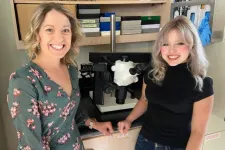(Press-News.org) URBANA, Ill. -- A bad case of the flu during pregnancy can increase the risk for fetal neurodevelopmental disorders such as schizophrenia and autism spectrum disorder. But it’s not the virus itself doing the damage; it’s the mother’s immune response.
New University of Illinois Urbana-Champaign research using live mouse-adapted influenza virus improves upon previous mouse experiments to explain the process on a cellular and molecular level. It also indicates fetal brain changes are more likely once the severity of the mother’s infection meets a specific threshold.
“Our data provide really compelling evidence for an infection severity threshold, which mimics what we see in humans. There are only a subset of maternal infections that are going to be severe enough to cause concerns like this. That said, pregnant people should definitely get the flu vaccine to reduce their risk,” said senior study author Adrienne Antonson, assistant professor in the Department of Animal Sciences, part of the College of Agricultural, Consumer and Environmental Sciences at Illinois.
The study is one of only a handful to investigate maternal infection in mice using live influenza virus at doses that replicate seasonal flu outbreaks in humans. “That means our results are more relevant to human pathological infection,” said lead study author Ashley Otero, a doctoral student in the Neuroscience Program at Illinois.
Antonson’s team infected pregnant mice with live influenza A virus, rather than a viral mimic — an inert molecule that mimics viral behavior — used by most research groups in recent decades. The viral mimic elicits the innate immune response, broadly categorized as non-specific inflammation, that occurs within 24 to 48 hours of infection.
These studies have provided important clues about which inflammatory proteins are made by the mother and how they interact with the fetal brain. But Otero says viral mimics may prompt slightly different immune responses than the live virus in both mother and fetus, and they fail to capture what happens during the mother’s adaptive immune response, which occurs later and helps an animal “remember” past infections.
To address these issues, the team subjected the mice to one of two doses of the virus — representing a moderate or severe infection — at the moment in gestation closest to the end of the first trimester in humans. Then, at two and seven days post-infection, they tracked how the infection progressed in the lungs and intestines of the mother, as well as how products from the mother’s immune response interacted with the fetal brain. They also measured the physical properties of fetal brains, including the thickness of the cortex, which has been linked to neurodevelopmental disorders in humans.
Several important viral mimic studies in mice have implicated an immune protein called interleukin-17 — primarily manufactured by T helper (Th)-17 cells in the mother’s intestinal tract — in changes to the fetal brain and neurodevelopmental disorder-like behaviors after birth. But the live virus didn’t activate that protein.
“At first, when I saw that interleukin-17 was not elevated in our moms from influenza infection, I was convinced we wouldn’t see any changes in the developing fetal brain,” Otero said. “But interestingly, we did see very similar responses in the developing neocortex, including dramatic reductions in the upper neuronal layers in fetuses from moms who had the higher-dose infection.”
Otero further explains that postmortem human studies have documented smaller cortical structures in people with schizophrenia and autism spectrum disorder. “So, our results were really in line with what we see in human brains.”
Antonson added, “We don’t think it's ever going to be just one inflammatory molecule that's causing all these different things. But this is the first time this pathway has been thoroughly investigated and compared against models that, thus far, have demonstrated that interleukin-17 is really involved. That’s why it’s important to move beyond viral mimic models to the true live virus.”
Having ruled out interleukin-17, at least at the time points they studied, the team tracked immune cells in the fetal brain. Microglia, which infiltrate the brain and interact with developing neurons, had signatures of increased inflammatory activity in fetuses from high-dose flu-infected mothers. Fetal border-associated macrophages (BAMs), which border the brain’s surfaces and provide constant immune surveillance, were also more active and abundant. Both cell types normally aid in healthy brain development, but Otero and Antonson think that when they’re spurred into an overactive state, they could attack instead of support healthy developing neurons.
Viral mimic studies have also implicated overactive microglia in causing fetal brain deformities, but BAM activity is vastly understudied. Otero plans to follow up with more research to understand the role of BAMs in prenatal influenza infection.
Antonson emphasizes that maternal infection is only one of many risk factors for neurodevelopmental disorders.
“These disorders are caused by a multitude of elements, including environmental factors, genetics, pharmacological exposures, and more. We're focusing on just this in-utero period, but the early postnatal period is important, and adolescence is important. It’s just one slice of a very complicated pie.”
The study, “Influenza A virus during pregnancy disrupts maternal intestinal immunity and fetal cortical development in a dose- and time-dependent manner,” is published in Molecular Psychiatry [DOI: 10.1038/s41380-024-02648-9]. The research was supported by the Roy J. Carver Charitable Trust (grant #23-5683), USDA NIFA Research Capacity Fund (Hatch project #ILLU-538-940), the Department of Animal Sciences, and the College of ACES.
Antonson is also affiliated with the Beckman Institute, the Microbial Systems Initiative, and the Carl R. Woese Institute for Genomic Biology at Illinois.
END
Fetal brain impacted when mom fights severe flu: New mouse study explains how
2024-07-29
ELSE PRESS RELEASES FROM THIS DATE:
A camera trap for the invisible
2024-07-29
DURHAM, N.C. -- It sounds fantastical, but it’s a reality for the scientists who work at the world’s largest particle collider:
In an underground tunnel some 350 feet beneath the France–Switzerland border, a huge device called the Large Hadron Collider sends beams of protons smashing into each other at nearly the speed of light, creating tiny eruptions that mimic the conditions that existed immediately after the Big Bang.
Scientists like Duke physicist Ashutosh Kotwal think the subatomic debris of these collisions could contain hints ...
Neurodivergent children are twice as likely to experience chronic disabling fatigue in adolescence
2024-07-29
The research, led by Dr Lisa Quadt, Research Fellow in Psychiatry at BSMS and Dr Jessica Eccles, Reader in Brain-Body Medicine at BSMS, highlights a significant link between neurodivergence and chronic fatigue. The study found that increased inflammation in childhood, often resulting from heightened stress levels, may be a contributing factor. This supports previous findings that suggest chronic fatigue can be rooted in inflammatory processes.
“These results show the importance of trans-diagnostic screening for children and the need for better support for neurodivergent children” says Dr Quadt. “Children with neurodivergent ...
Engineers use data to manage grid transformers, boosting reliability to homes, farms
2024-07-29
AMES, Iowa – Pay attention the next time you drive near your home, farm or business. You’ll notice small, green utility boxes all over the place. They’re distribution transformers. If they’re not working properly, electricity won’t flow to your lights and appliances.
Those boxes take kilovolts of electricity (that’s high voltage, measured in 1,000s of volts) from transmission lines and step it down to the safer, practical 120 or 240 volts that power our daily lives.
“Utilities have plenty of them,” said Zhaoyu Wang, an Iowa State University professor of electrical and computer engineering. “Most of them only ...
PSU awarded $1.9M NOAA grant to address microplastic pollution in coastal communities
2024-07-29
Portland State University (PSU) has been awarded $1,976,806 from the National Oceanic and Atmospheric Administration's (NOAA) National Sea Grant Marine Debris Challenge Award Program to lead an innovative and collaborative three-year project to address microplastic pollution on the Oregon coast.
This grant is part of a $27 million project between the U.S. Department of Commerce and NOAA. Portland State will host one of 11 projects that received a total of $25 million in funding across Alabama, California, Florida, Illinois, Massachusetts, New York, North Carolina, Oregon, Texas and Wisconsin. These projects ...
Association for Molecular Pathology announces 2024 award recipients
2024-07-29
ROCKVILLE, Md. – July 29, 2024 – The Association for Molecular Pathology (AMP), the premier global molecular diagnostic professional society, today announced the recipients of this year’s Excellence in Molecular Diagnostics, Jeffrey A. Kant Leadership, and Meritorious Service Awards. These prestigious accolades will be presented to the winners this November during AMP’s 2024 Annual Meeting & Expo in Vancouver, British Columbia.
Award for Excellence in Molecular Diagnostics
Atul Butte, MD, PhD
Priscilla Chan and Mark Zuckerberg Distinguished ...
Mutations in DNA damage repair genes associated with response to cisplatin in bladder cancer: Prospective validation from SWOG S1314 trial
2024-07-29
An analysis of pre-treatment tumor specimens from 105 patients with localized muscle-invasive bladder cancer found that the presence of a mutation in any one of three genes, all known to be involved in DNA damage repair, was associated with complete pathologic response to cisplatin-based neoadjuvant chemotherapy as measured by pathological downstaging at the time of bladder surgery. Results are published in the journal European Urology.
“The SWOG S8710 randomized trial provided Level 1 evidence supporting ...
Timber plantations near urbanized areas support the movement of small and medium-sized terrestrial mammals between patches of natural forest
2024-07-29
In the fight to mitigate climate change and deforestation in the tropics, timber plantations have emerged as a promising strategy for reforesting degraded land and connecting patches of natural forest. Often, these are species with commercial value for landowners but are not native to the region. To evaluate how well non-native tree plantations support native wildlife in heavily human-impacted areas, researchers from the Smithsonian Tropical Research Institute (STRI), the Max Planck Institute of Animal Behavior (MPI-AB), Wageningen University & Research, and the University of California – Davis surveyed over 200 hectares of timber plantations ...
Wang receives funding for Experiential Learning Program
2024-07-29
Wang Receives Funding For Experiential Learning Program
Zhengdao Wang, Professor, Cybersecurity Engineering, College of Engineering and Computing (CEC), received $14,000 from Old Dominion Research Foundation for: “CCI—2024 Experiential Learning Program/Water System Infrastructure - Innovative Experiential Learning.”
Wang intends to enhance awareness and understanding of cybersecurity risks associated with public water systems by developing an educational simulation game, "CyberShield H2O."
He will provide ...
Everyday activities aren’t enough to protect against stroke
2024-07-29
Research conducted at the University of Gothenburg shows that the physical activities we do as we go about our lives, at work or in the home, aren’t enough to protect us from having a stroke. However, exercising in our free time and using active modes of transport are associated with a decreased risk of stroke.
“Physical activity during leisure time and as transportation is becoming increasingly important now that many jobs and domestic activities are becoming more sedentary,” says lead ...
Deciphering the role of mitochondrial DNA targeted therapy in hepatic cell carcinoma
2024-07-29
Hepatic cell carcinoma (HCC), the fifth most prevalent malignancy worldwide and the fourth leading cause of cancer-related mortality, poses significant therapeutic challenges. Despite advancements in medical research, late-stage HCC patients have a dismal five-year survival rate of less than 20%. The complexity of liver cancer development involves an intricate interplay of genetic and environmental factors. Among these, mitochondrial alterations and mutations in mitochondrial DNA (mtDNA) are increasingly recognized as critical contributors to cancer pathogenesis. These changes not only impair cellular bioenergetics ...





